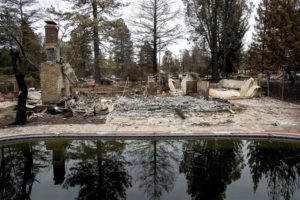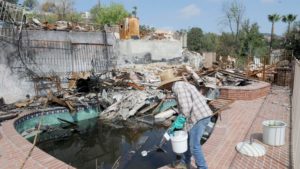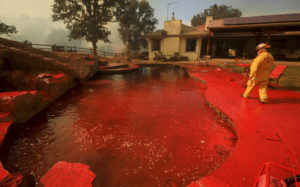
Pool care and repair after fires
 Last year was one of California’s most devastating wildfire seasons in recorded history. According to the California Department of Forestry and Fire Protection, the Golden State saw more than 7,500 fires consume 1.6 million acres of land. And in November, the Woolsey Fire and Camp Fires caused unprecedented damage, becoming California’s deadliest and most destructive wildfire on record.
Last year was one of California’s most devastating wildfire seasons in recorded history. According to the California Department of Forestry and Fire Protection, the Golden State saw more than 7,500 fires consume 1.6 million acres of land. And in November, the Woolsey Fire and Camp Fires caused unprecedented damage, becoming California’s deadliest and most destructive wildfire on record.
With a new year before us and wildfire season just around the corner, here are some tips for dealing with customers who have pools in or around wildfire-prone areas of the country.
During the fire
Use extreme caution in and around areas where wildfires are still active. Protective gear such as respiratory masks, goggles and gloves may be required in these situations. It is prudent to carry emergency supplies on your truck at all times, which can include bottled water, safety flares, a protective non-flammable blanket, a battery-powered radio and a flashlight.
In the case of active fires, the first concern should always be the immediate safety of people. To that end, it is vital to comply with emergency management. Never cross an emergency barrier or evacuation zone to work on a pool — fires can change course rapidly, especially in areas of high winds, and it’s imperative that you keep yourself safe. If your route is anywhere near a wildfire, make sure to have several escape routes mapped out ahead of time.
Even if you are not immediately in a fire zone, smoke and ash can be a problem miles beyond the fire. In the summer of 2017, smoke from fires in British Columbia spread all the way down to the Seattle area, causing pools to develop filter issues and algae blooms. For this reason, service techs outside a wildfire perimeter but still within range of smoke and ash should monitor water chemistry and filter performance.
 Water demand surges both during and after a wildfire, meaning residents trying to protect their property may encounter low water pressure. In such an event, pool water may become a valuable resource for fighting fires. Some fire departments have special pumps that enable them to draw pool water to protect homes. Homeowners and service professionals can also buy pumps to soak down their property; these pumps can typically work at a flow of 150 GPM and can disperse the contents of a 20,000-gallon pool within two hours.
Water demand surges both during and after a wildfire, meaning residents trying to protect their property may encounter low water pressure. In such an event, pool water may become a valuable resource for fighting fires. Some fire departments have special pumps that enable them to draw pool water to protect homes. Homeowners and service professionals can also buy pumps to soak down their property; these pumps can typically work at a flow of 150 GPM and can disperse the contents of a 20,000-gallon pool within two hours.
However, pools located in areas with a high groundwater table, or positioned over an underground spring, have a high risk of popping out of the ground. To prevent this, pool techs should ensure hydrostatic relief valves are in place.
Wildfires are often accompanied by high winds, which can result in debris of all types — smoke, ash, tree branches, leaves, fire suppressant chemicals, etc. — contaminating pool water. Animals may also seek shelter in swimming pools. In these situations, do not approach the animals on your own. Instead, immediately contact your local animal control or wildlife management officials.
Cleanup after the fire
 In post-fire pool cleanup, the first and most important step is staying safe. Be aware of downed power lines. It’s common for the fire department to turn off power in fire-damaged homes because wires have melted or fused together from the heat. Be sure to check with the fire department before attempting to turn pump and filter breakers back on. Only a licensed electrical contractor should determine the integrity of the breakers for the pumps.
In post-fire pool cleanup, the first and most important step is staying safe. Be aware of downed power lines. It’s common for the fire department to turn off power in fire-damaged homes because wires have melted or fused together from the heat. Be sure to check with the fire department before attempting to turn pump and filter breakers back on. Only a licensed electrical contractor should determine the integrity of the breakers for the pumps.
As outlined above, swimming pools in fire areas can contain significant amounts of debris. Since it is impossible to determine exactly what has gotten into the pool, it is best (when allowable) to drain and refill it. While doing this, inspect the integrity of the pool walls, interior finishes, pipe fittings, decking and surrounding landscape.
Below are some of the most common debris you’ll encounter:
Smoke
Smoke is corrosive and will cause severe damage wherever it settles, including the equipment, structures and pool water. If equipment and decking are covered in ash and smoke, use caution. Wear personal protective equipment and breathing apparatus as well as gloves. There are many toxins in smoke and ash residue that may be hazardous to human health; in these cases, it is best to allow professionals to deal with excessive cleanup situations.
Ash
You’re likely to encounter a lot of ash in fire-impacted pools. The ash that results from fires that burn lower than 840 degrees Fahrenheit is mostly organic carbon. At a higher temperature, the carbon is burned away, leaving inorganic compounds behind like calcium, magnesium and sodium.
Fires like those in California burn not only forests but also buildings. The combustion rate is much higher for buildings and the makeup of the corresponding ash is significantly different. At a very high combustion rate, the ash can contain potassium and calcium oxides, which create quicklime. If enough of this ash gets into the pool and then to the filter, it can create a limestone cement coating on the filter media. Ash from homes and other structures can also contain toxins such as lead, arsenic and hexavalent chromium. Most ash that lands in pool water is also hydrophobic and repels water — which explains why ash floats and is so difficult to remove by skimming. To make it easier to remove, you can use a chitosan clarifier or an enzyme, which changes the charge of the ash.
Fire-fighting suppressants
Most of the dry suppressants dropped on wildfires are made primarily of diammonium phosphate, which results in heightened phosphate levels in waterways and pools. Phosphate in pools leads to many water-quality issues and can combine with calcium to form calcium phosphate scale on heat exchangers.
Further cautions
Extreme heat from fires can cause the ground to bake, turn solid and repel water. This is a condition known as hydrophobicity. When rains come, the hydrophobic condition of the soil increases the rate of water run-off. Water can concentrate in these areas, causing erosion. That erosion can be exacerbated by firefighting efforts, leading to flooding during rains. Therefore, pool areas need to be protected with sandbags or other diversion methods to prevent an influx of floodwater in the pool.
Pools drained during the fire must be inspected for damage to interior finishes, deck areas and all equipment connections. Most likely, these pools will need resurfacing before regular use can begin.
Post-fire cleanup checklist:
If pools on your route were in a wildfire’s immediate path, follow these steps:
- Use extreme caution in areas where wildfires are active.
- Always check ahead of time with emergency management personnel before attempting to enter neighborhoods where fires have been.
- Wear smoke protection when necessary (breathing mask and goggles).
- Since water in pools can contain toxins from smoke, ash and firefighting suppressants, it is best to drain when possible. No one should ever swim in a pool in the immediate aftermath of a fire.
- Remember that wildfires can move quickly and change course in seconds. Have more than one escape route planned ahead of time. It is best to stay out of the area.
- The use of shocking and flocking chemicals, phosphate removal treatments, enzymes, filter aids and algicides are all good remedial treatments once the fires are gone.
- Check and inspect all equipment thoroughly during the cleanup process. Filters may need to be backwashed and cleaned frequently.
- Ensure pools equipped with firehose pumps also have hydrostatic relief valves to prevent popping caused by rapid draining.
- Be aware of erosion and flooding problems that may occur from damaged soil. Sandbag any vulnerable areas in advance. Ensure that the flow of water is to drains and culverts to prevent flooding.
In cases where homes are not damaged by a fire but are located in the vicinity of a fire, take the following steps:
- Remove all larger debris as soon as is possible.
- Brush all surfaces thoroughly.
- Skim smaller material with a pool net.
- Make sure filter is clean and in operational order.
- Inspect all equipment.
- Superchlorinate the pool to 20 ppm or use a quality chlorine-free oxidizer.
- Follow immediately with a clarifier or filter aid material to help remove small ash material to the filter.
- Use an enzyme to help break down some un-filterable non-living organic material.
- Test and treat for phosphates once the chlorine levels have come down below 5 ppm.
- Add a good broad-spectrum algaecide.
- Clean filter as necessary throughout this process.
This article originally appeared in the January 2019 issue of AQUA Magazine and is reprinted with permission.







